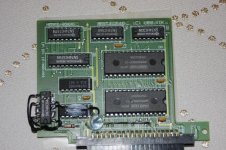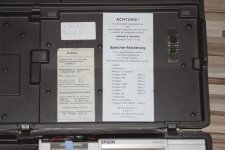macieksoft
Member
Hi. It's my first post on the forum so i'd like to explain some things.
I live in Poland and when i found Epson HX-20 on local auction portal for 150zł (less than 50$) i couldn't resist.
I bought one from the guys who are specialized in post military (demobilized) equipment.
I have some questions about it.
First is how it was used in military? Anybody has any ideas? I heard that HP41 calculators were used onboard flying tankers to calculate things like center of gravity. Some people reports about various programmable calculators from 80s that have been used as MBCs (Mortar Ballistic Computers).
But how was HX-20s used in Bundeswehr? I'd like to know what was the use of the device i have.
I found this one quite unusual. First are the ROM modules that turns out to be EPROMs with stickers on them (they seems to protect those little windows from UV radiation like it used to be with EPROMS). I heard that orignal ones had mask one time programmable PROMs and no EPROMs like mine have. I am talking about ones that stores firmware with BASIC interpreter and so on, the extra EPROM slot is free (there is no chip in it).
The unusual thing is the rater exotic memory expansion board that fits inside. It's smaller than the other internal expansion boards i seen on internet. It seems to use 2 SRAM chips and regarding to datasheet they have 32kB each so it gives 64kB total.
Epson HX-20 can adress only 16kB of memory trough it's expansion port (it has 16kB of RAM by default so when you connect expansion it gives total of 32kB RAM).
This leds to conclusion that there must be software switching implemented (there are no DIP switches on the board) to utilize this 64kB of memory and turn them into banks of 16kB.
The interestning thing is that the module has to be "activated" trough a specal procedure printed on the case. Before activation HX-20 shows 12891 bytes of free memory available to user so it's like any unexpanded HX-20. After going trough procedure it shows 29275 bytes so it's like HX-20 with expansion unit.
So the questions are:
-How it was used in Bundeswehr?
-How to utilize software switching to use the enteire memory in this unusual memory expansion unit?
Below there are photos of the memory expansion board and expansion unit activation procedure.


I live in Poland and when i found Epson HX-20 on local auction portal for 150zł (less than 50$) i couldn't resist.
I bought one from the guys who are specialized in post military (demobilized) equipment.
I have some questions about it.
First is how it was used in military? Anybody has any ideas? I heard that HP41 calculators were used onboard flying tankers to calculate things like center of gravity. Some people reports about various programmable calculators from 80s that have been used as MBCs (Mortar Ballistic Computers).
But how was HX-20s used in Bundeswehr? I'd like to know what was the use of the device i have.
I found this one quite unusual. First are the ROM modules that turns out to be EPROMs with stickers on them (they seems to protect those little windows from UV radiation like it used to be with EPROMS). I heard that orignal ones had mask one time programmable PROMs and no EPROMs like mine have. I am talking about ones that stores firmware with BASIC interpreter and so on, the extra EPROM slot is free (there is no chip in it).
The unusual thing is the rater exotic memory expansion board that fits inside. It's smaller than the other internal expansion boards i seen on internet. It seems to use 2 SRAM chips and regarding to datasheet they have 32kB each so it gives 64kB total.
Epson HX-20 can adress only 16kB of memory trough it's expansion port (it has 16kB of RAM by default so when you connect expansion it gives total of 32kB RAM).
This leds to conclusion that there must be software switching implemented (there are no DIP switches on the board) to utilize this 64kB of memory and turn them into banks of 16kB.
The interestning thing is that the module has to be "activated" trough a specal procedure printed on the case. Before activation HX-20 shows 12891 bytes of free memory available to user so it's like any unexpanded HX-20. After going trough procedure it shows 29275 bytes so it's like HX-20 with expansion unit.
So the questions are:
-How it was used in Bundeswehr?
-How to utilize software switching to use the enteire memory in this unusual memory expansion unit?
Below there are photos of the memory expansion board and expansion unit activation procedure.



